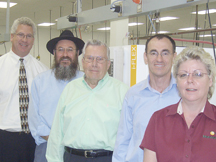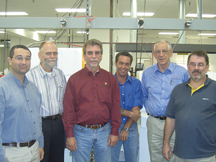By Andrew Karp
Group Editor, Lenses and Technology
OMAHA, Neb.--Although Rite-Style Optical is one of the leading optical wholesale laboratories in the U.S. and has kept pace with lens processing methods, it has rarely if ever pushed the technology envelope in its 58 years in business.
 |
| George Lee of Rite-Style Optical, third from left, with executives from the three companies that created Rite-Style’s integrated direct surfacing lens production process. From the left are Larry Clarke, Satisloh; Hilaire van der Veen, Shamir Insight; Dan Katzman, Shamir; Robin Cassidy, VisionStar. |
 |
| Members of the team that implemented Rite-Style Optical’s direct surfacing lens processing system. Pictured in the lab, left to right are Yuval Carmon, Shamir; Ray Stavneak, Rite-Style; John Greco, VisionStar, Dave Nordstrom, Rite-Style; Jerry Thornhill, Shamir Insight; Kimber Rarick, Satisloh. Not pictured: Jeff Pratt, VisionStar. Carmon and Pratt led the software development effort that enabled the integration of the LDS and LMS. |
That is about to change this month as the Omaha-based wholesaler becomes the first independent lab in the country to launch a fully-integrated direct surfacing lens production process. The innovative process enables Rite-Style to manufacture Shamir Freeform progressive lenses in a seamless production flow. By transforming common single-vision, spherical lens blanks into progressive lenses with sophisticated designs, the lab can significantly reduce its lens inventory while increasing the accuracy of the prescriptions. This technological feat requires the integration of a lab management system (LMS) created by VisionStar with Shamir’s lens design software (LDS) which generates a “point file” containing proprietary lens design data (see sidebar). The integrated LMS-LDS system then feeds the data to lens surfacing equipment supplied by Satisloh.
The three vendors were brought together six months ago when George Lee, Rite-Style’s 83-year-old owner and chief executive officer, decided the lab needed make a leap forward into the emerging area of direct surfacing, which Shamir refers to as “Freeform Technology.”
“I wanted us to be an experimental lab,” said Lee. “This is the first time there has been a complete way of doing this, from data entry to generating a freeform lens.
“There’s no limitation on the products we can freeform,” explained Lee. “We can make lenses in any material.”
Although a handful of U.S. labs have recently begun producing progressives using direct surfacing technology, Rite-Style has accomplished something unique, according to the vendors who took part in the project. “This is the first time we have all come together to make this a seamless process,” said Larry Clarke, president of Satisloh North America.
Rite-Style uses three Satisloh machines to produce the lenses: the VFT Compact Generator, i-Flex Flexible Tool Polisher and Lens- Engraver-LC. The i-Flex eliminates the need for conventional laps; the Lens Engraver marks the lenses with a laser engraving after they are transformed from single-vision spherical blanks into progressives.
“Rite-Style has become a lens manufacturer,” remarked Hilaire van der Veen, chief executive officer of Shamir Insight, Shamir’s North American arm. “They can make a much wider range of product from the same inventory and can upgrade their lenses designs at any time. They can also select which products to use it on. This represents a paradigm shift. The model for producing progressive semi-finished blanks is about to change.”
Robin Cassidy, president of VisionStar, credited Lee for embracing the new technology. “George is being innovative,” she said. “He’s saying independents can be in this market, and he’s showing others it can be done.”
| Understanding the Process Flow for Integrated Direct Surfacing |
|
To create a “seamless” production flow for the direct surfacing of progressive lenses at Rite-Style, a team of technology experts from Satisloh, Shamir and VisionStar integrated the Laboratory Management System (LMS) with the Lens Design Software and lens processing equipment. The result is a sophisticated process based on a new, proposed protocol developed by the Vision Council of America that consists of the following steps:
|











